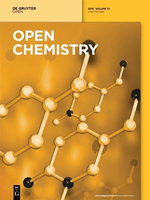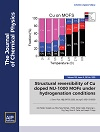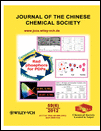
ChemSystemsChem
Scope & Guideline
Advancing Chemistry Through Interdisciplinary Innovation
Introduction
Aims and Scopes
- Systems Chemistry:
The journal emphasizes the study of chemical systems as a whole, rather than isolated reactions, encouraging research that reveals the emergent properties of complex interactions. - Prebiotic Chemistry and Origins of Life:
A significant focus is placed on exploring chemical pathways and mechanisms that could explain the origins of life, including studies on protocells, prebiotic reactions, and molecular evolution. - Supramolecular Chemistry:
Research on the design and function of supramolecular systems is prevalent, particularly those that mimic biological processes or exhibit dynamic behaviors. - Artificial Molecular Systems:
The development of synthetic systems that replicate or are inspired by biological functions, such as molecular machines and self-assembling structures, is a core area of interest. - Dynamic and Adaptive Materials:
The journal covers studies that investigate materials capable of dynamic behavior and adaptability, including self-healing materials and systems responsive to environmental stimuli. - Interdisciplinary Approaches:
ChemSystemsChem encourages contributions from various scientific disciplines, integrating concepts from biology, physics, and engineering to enhance the understanding of chemical systems.
Trending and Emerging
- Chemical AI and Computational Chemistry:
There is a growing trend toward leveraging artificial intelligence and computational methods to understand and predict chemical behaviors, reflecting the increasing integration of technology in chemical research. - Self-Assembly and Dynamic Systems:
Research on self-assembling systems and their dynamic properties has surged, emphasizing the importance of understanding how molecular interactions lead to complex structures and behaviors. - Biomolecular Condensates and Phase Separation:
The study of biomolecular condensates and their role in cellular processes is gaining traction, highlighting the significance of liquid-liquid phase separation in biological systems. - Prebiotic Pathways and Molecular Evolution:
There is an increasing focus on elucidating prebiotic pathways and the chemical basis for molecular evolution, driven by a quest to understand the origins of life more comprehensively. - Autonomous and Responsive Materials:
Emerging research on materials that exhibit autonomous behavior and responsiveness to environmental stimuli is becoming a hallmark of the journal, showcasing innovations in smart materials and systems.
Declining or Waning
- Traditional Organic Synthesis:
Research strictly focused on traditional organic synthesis methods has waned, as the journal shifts towards more complex and integrative approaches that emphasize systems-level understanding over individual synthetic pathways. - Static Chemical Models:
There is a noticeable decrease in studies that utilize static models of chemical interactions, reflecting a broader trend towards dynamic and adaptive systems that better represent real-world chemical processes. - Inorganic Chemistry without Biological Context:
Papers centered around inorganic chemistry that do not connect to biological or prebiotic themes are becoming less frequent, as the journal increasingly prioritizes research that bridges inorganic chemistry with biological relevance. - Simplistic Reaction Mechanisms:
Research focusing on simplistic or isolated reaction mechanisms has diminished, as the journal emphasizes complex interactions and systems that reveal emergent properties.
Similar Journals

Ovidius University Annals of Chemistry
Diving Deep into the World of Chemical Innovation.Ovidius University Annals of Chemistry is a prominent open-access journal dedicated to the field of chemistry and chemical engineering, published by OVIDIUS UNIV PRESS since 2012. With its ISSN 1583-2430 and E-ISSN 2286-038X, this journal seeks to foster innovative research and disseminate knowledge across diverse chemical disciplines. Situated in the vibrant academic setting of Ovidius University in Constanta, Romania, this journal receives contributions from a global pool of researchers, enhancing its relevance in the international scientific community. The open-access format ensures that all published articles are freely available, promoting a wider reach and impact of the research dissemination. As a valued resource for academics, industry professionals, and students alike, the Ovidius University Annals of Chemistry plays a crucial role in advancing the understanding of chemical sciences and engineering practices.

Open Chemistry
Unlocking Innovative Discoveries in ChemistryOpen Chemistry, published by DE GRUYTER POLAND SP Z O O, is a distinguished peer-reviewed journal that has been serving the global chemistry community since its inception. With an ISSN of 2391-5420 and an E-ISSN also of 2391-5420, this open-access journal has been accessible to researchers and practitioners alike since 2015, ensuring a wide dissemination of high-quality research findings. Located in Germany, specifically at BOGUMILA ZUGA 32A STR, 01-811 WARSAW, MAZOVIA, POLAND, Open Chemistry aims to publish innovative research across various chemical disciplines, with special attention to miscellaneous chemistry and materials chemistry. It is currently ranked in the Q3 category for both fields as of 2023, reflecting its solid standing within the academic community, with specific ranks of 187/408 in General Chemistry and 153/317 in Materials Chemistry, corresponding to respective percentiles of 54 and 51. Open Chemistry not only enhances the accessibility of cutting-edge research but also serves as a vital resource for students, professionals, and scholars seeking to advance their knowledge in the rapidly evolving landscape of chemical sciences.

JOURNAL OF CHEMICAL PHYSICS
Charting New Territories in Physics and AstronomyJOURNAL OF CHEMICAL PHYSICS, published by AIP Publishing, stands as a premier scholarly source within the realms of physical and theoretical chemistry, as well as physics and astronomy. With an enduring history dating back to 1933 and converging until 2024, this journal has established itself as a cornerstone of the scientific community, evidenced by its prestigious Q1 categorization in multiple fields, including medicine and general physics. It is ranked 37th out of 243 in the general physics and astronomy category and holds a commendable 39th position in physical and theoretical chemistry according to Scopus rankings, highlighting its significant impact in these disciplines. Although not an open-access journal, it caters to a wide audience of researchers, professionals, and students seeking to deepen their understanding of the interactions and dynamics of chemical systems. With its expertly curated content, the JOURNAL OF CHEMICAL PHYSICS continues to play a vital role in advancing knowledge and fostering innovation across its core subjects.

EGYPTIAN JOURNAL OF CHEMISTRY
Transforming Ideas into Solutions in the World of ChemistryThe Egyptian Journal of Chemistry, published by the National Information & Documentation Centre (NIDOC), serves as a vital platform for disseminating novel research and advancements in the field of chemistry and its interdisciplinary applications. Established in 2004 and continuing its publication through 2024, this journal encapsulates a diverse range of topics including Biochemistry, Chemical Engineering, and Materials Science, reflected in its respectable Scopus rankings. With an array of Quartile rankings indicating its varying impact across different categories, scholars can benefit from its insights into innovative solutions and methodologies that address pressing scientific challenges. Although it currently does not operate under an open access model, researchers and students are encouraged to leverage its findings as it plays a pivotal role in the academic landscape of Egypt and beyond. For those engaged in chemical research, the Egyptian Journal of Chemistry stands as an essential resource, contributing significantly to the global body of scientific knowledge.

Chemija
Fostering Innovation Through Rigorous Research.Chemija is a prominent journal in the field of chemistry, published by LIETUVOS MOKSLU AKAD LEIDYKLA in Lithuania. With a focus on diverse topics within the realm of chemistry, this journal aims to disseminate original research articles, reviews, and discussions that advance the understanding and application of chemical science. Although it currently holds a Q4 ranking in the miscellaneous category of chemistry, Chemija is committed to elevating its impact through the publication of high-quality research, making significant contributions to the discipline. The journal operates under a non-open access model, ensuring that articles undergo rigorous peer review to uphold academic standards. Researchers, professionals, and students are encouraged to explore the wealth of knowledge within its pages as it endeavors to bridge gaps across various subfields of chemistry from 2008 to 2024. With a dedicated readership and a growing database of insightful publications, Chemija serves as an essential resource in the ever-evolving landscape of chemical research.

Orbital-The Electronic Journal of Chemistry
Illuminating the Path of Chemical DiscoveryOrbital - The Electronic Journal of Chemistry, ISSN 1984-6428, is an esteemed open-access journal published by the Universidade Federal de Mato Grosso do Sul, Department of Chemistry, since 2009. Located in the vibrant academic landscape of Campo Grande, Brazil, this journal aims to bridge the gap between research and practice in the fields of Chemistry, Chemical Engineering, and Materials Science. Despite its current categorization in the Q4 quartile ranks, Orbital plays a pivotal role by providing a platform for innovative ideas, emerging technologies, and interdisciplinary research that advances the understanding of chemical processes and materials. With its commitment to open access, the journal ensures that research findings are readily available to a global audience, promoting collaboration and knowledge dissemination among researchers, professionals, and students alike. Readers can expect a diverse range of articles, from foundational chemistry studies to cutting-edge developments in materials science, reflecting the journal’s dynamic scope and contribution to the scientific community.

Nature Chemistry
Connecting Researchers to the Pulse of Chemistry.Nature Chemistry is a prestigious journal published by NATURE PORTFOLIO, focusing on groundbreaking research in the realms of chemistry and chemical engineering. Since its inception in 2009, this esteemed publication has garnered significant recognition, currently ranking in the Q1 category for both Chemical Engineering and Chemistry (miscellaneous) as of 2023. With an impactful presence, it ranks 4th out of 273 in General Chemical Engineering and 9th out of 408 in General Chemistry, placing it within the top 2% of journals in its field. Nature Chemistry aims to publish high-quality, peer-reviewed articles that advance our understanding of chemical science and its applications, catering to an audience of researchers, professionals, and students eager to explore innovative discoveries. While it offers various access options, dedicated readers appreciate its contribution to the scientific community from its base in Berlin, Germany.

JOURNAL OF THE CHINESE CHEMICAL SOCIETY
Bridging Theory and Practice in Chemical SciencesJOURNAL OF THE CHINESE CHEMICAL SOCIETY, published by WILEY-V C H VERLAG GMBH, is a vital resource in the field of chemistry, focusing on a broad array of topics pertinent to general chemistry and its advancing sub-disciplines. Established in 1954 and running through 2024, this journal serves as a significant platform for the dissemination of high-quality research, showcasing innovative findings and developments within the chemical sciences. With its Q3 category ranking and positioning at Rank #203 in General Chemistry per Scopus, it reflects the journal's commitment to research excellence and impact. While not an open-access publication, it ensures accessibility to a global audience, making it an essential tool for researchers, professionals, and students alike seeking to stay informed and engaged in the evolving landscape of chemistry.

ANGEWANDTE CHEMIE-INTERNATIONAL EDITION
Cutting-edge Insights into Catalysis and ChemistryANGEWANDTE CHEMIE-INTERNATIONAL EDITION, published by WILEY-V C H VERLAG GMBH, stands as a leading journal in the fields of Chemistry and Catalysis, holding a prestigious position with a Q1 ranking in both categories as of 2023. With an ISSN of 1433-7851 and an E-ISSN of 1521-3773, this esteemed publication has been an invaluable resource for the global scientific community since its inception in 1962. The journal's impact is further underscored by its remarkable Scopus rankings, where it occupies the 13th place among 408 journals in General Chemistry and the 4th place among 68 in Chemical Engineering - Catalysis, marking it in the 96th and 94th percentiles, respectively. Although it does not offer Open Access, ANEWANDTE CHEMIE-INTERNATIONAL EDITION remains essential for researchers, professionals, and students seeking to stay abreast of cutting-edge developments and innovations in chemical sciences. Its comprehensive scope and rigorous peer-review process ensure that only the highest quality research finds its way to publication, contributing significantly to the advancement of chemistry worldwide.

JOURNAL OF THE SERBIAN CHEMICAL SOCIETY
Empowering Researchers with Open Access KnowledgeJOURNAL OF THE SERBIAN CHEMICAL SOCIETY, an esteemed publication in the field of chemistry, is published by the SERBIAN CHEMICAL SOCIETY and has been an essential platform for the dissemination of research since 1930. With an ISSN of 0352-5139, this Open Access journal is dedicated to fostering communication and collaboration among chemists worldwide, making its contents readily accessible to researchers, professionals, and students alike. Based in Serbia, the journal features a wide range of topics within the domain of general chemistry, as reflected in its Scopus rankings, which place it in the 34th percentile among its peers. The journal's engagement with the global scholarly community is further underscored by its consistent publication history since 1985, with coverage extending through to 2024. As the journal continues to evolve, it remains committed to promoting high-quality research and advancing the field of chemistry.